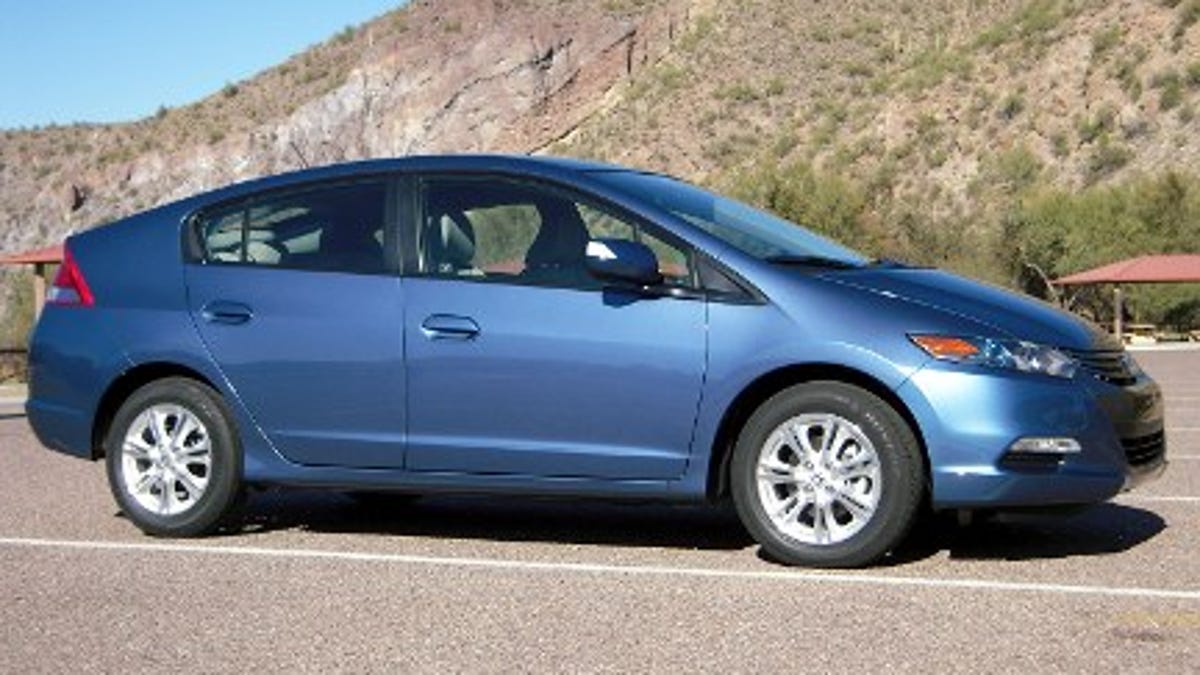Driving the 2010 Honda Insight
What it's like to drive the 2010 Insight, Honda's upcoming entry-level hybrid.

I had the opportunity to spend a few hours driving a 2010 Honda Insight on city streets and backroads of Carefree, Ariz., a suburb of Phoenix, when it was introduced to the automotive media last month.
Driving the 2010 Honda Insight is a bit different from driving any other CVT-equipped car. Regenerative braking is noticeable on deceleration, allowing less use of the antilock disc/drum hydraulic brakes. There are also two new features on the Insight not found in other cars--EcoAssist and Econ mode.
With 98 horsepower, developed fairly high in the rev range at 5,800rpm, and 123 pound-feet of torque from the combined efforts of the engine and electric motor from a low 1,000rpm to 1,500rpm, and about 3,000 pounds of combined car and a couple of passengers, the new Insight doesn't exactly compare with a Civic Si. However, it is an entertaining drive. I don't think Honda could make a boring car if it tried.
Acceleration, while not blistering, is adequate for everyday use. Response from the electrically-assisted rack and pinion power steering is good, and never too light. The MacPherson strut front, torsion beam rear suspension is similar in design to that found in a Fit, and tuned for a good balance between ride comfort and handling. On the road, the Insight feels smaller and more nimble than a Civic Hybrid, which I had driven several weeks previously and had the opportunity to try again after driving the Insight. Ride quality and handling are similar to a Fit, hardly a complaint.
With electronic control of everything controlling the engine, such as throttle control, ignition timing, and fuel injection, the capability of fine-tuning of an engine's response to driver input has been available for a few years. I first experienced it in a BMW M3 with the SMG automated manual gearbox back in 2002. The right combination of switches resulted in hair-trigger throttle response and slam-bang shifting under heavy-throttle acceleration. The Insight's Econ mode is similar in how it works and what it affects, but it is diametrically opposite in what it does. Throttle response is softened, and the engine and CVT control software ignores small throttle changes made by the driver. More foot motion is required for any changes, and foot-to-the-floor driver action (or pressing the button again) cancels Econ mode.
What it does is give a milder feel to the car, with some rate of acceleration traded for improved fuel economy. It also increases regenerative braking, and the amount of time the engine is stopped when it might otherwise be idling, further improving fuel economy. 0 mph = 0 mpg otherwise.
Further improvement in fuel economy is helped by Eco Assist. This could be seen as the next step from the green "eco" light on the dash of V6 Accords and Pilots with the Variable Cylinder Management System. Only instead of one small light telling the driver that is getting commendable fuel economy, the speedometer background changes color. Blue means you're a guzzler. Blue-green means that you're starting to get with the program. Green means, well, you're green, with excellent fuel consumption and consequent lowest emissions.
To further educate and entertain, the car's trip computer keeps score, and displays fuel consumption history on a bar graph so drivers can keep track and improve on economy. Green driving is scored in leaves, with more leaves being better. Also, for the first time in a Honda hybrid, the power mode can be displayed in real time. Since the engine never stops rotating--fuel and spark are cut off and the valve held open when it's deactivated--it's been nearly impossible to tell what's providing power at any given time in a Honda hybrid. This is no longer an issue.
A fun-to-drive driving experience is part of Honda's heritage. This, after all, is the company that brought us the CRX hatchback that showed that good fuel economy could be quick and fun. The S2000 proved that high specific power output and performance weren't necessarily environmentally destructive. The second-generation Insight isn't fun like those sport-oriented machines, but it is enjoyable. It has the responsive handling that is part of Honda's makeup, and that counts more than sheer speed. Also, Econ mode is an interesting experience.
During the morning's longest ride-and-drive segment, my co-driver and I kept our Insight in Econ mode more often than not. It seemed to fit the car's personality, and made smooth, gentle driving the order of the day. Over a hundred miles of city streets and rural roads, with flat sections and steep hills alike, and with minimal use of freeways, we got 50 mpg. Huh? Didn't the EPA rate this 40 mpg for city driving and 43 mpg for highway? We usually weren't trying for maximum economy, or trying to keep the speedometer background glowing green. Maybe it was the combination of moderate speeds and light traffic, but it was not difficult at all to get excellent fuel economy, without hindering traffic in any way.
Sometimes it is easy being green.